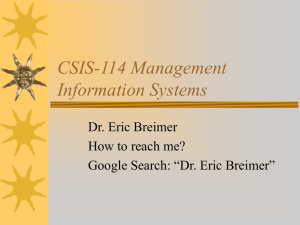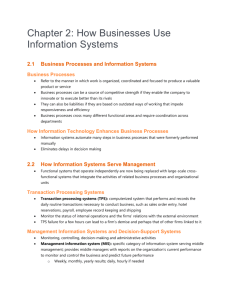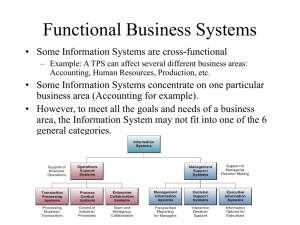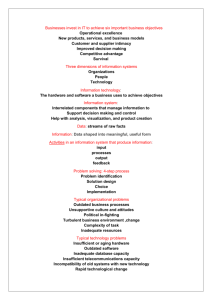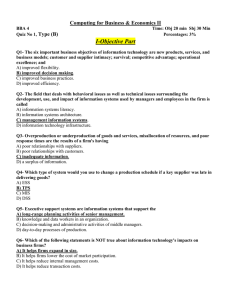chpt1-2
advertisement
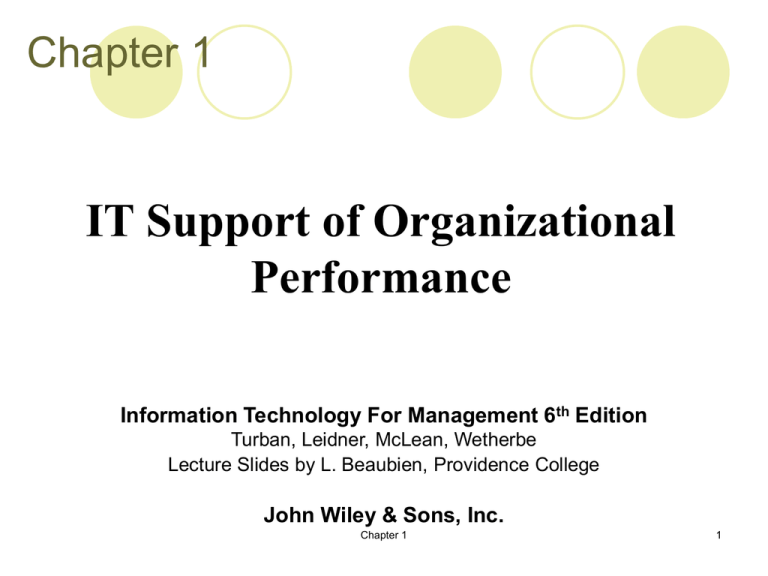
Chapter 1 IT Support of Organizational Performance Information Technology For Management 6th Edition Turban, Leidner, McLean, Wetherbe Lecture Slides by L. Beaubien, Providence College John Wiley & Sons, Inc. Chapter 1 1 Learning Objectives Describe the digital economy and digital enterprises Recognize the relationship between performance, organizational pressures, and responses and technology Define IS and IT Understand what the adaptive enterprise is Chapter 1 2 Learning Objectives (Continued) Understand the support role that IS and IT play in the organization Understand the importance of learning about IT Chapter 1 3 Digital Economy – “New” Economy E-Business: The use of electronic technologies to transact business Collaboration: People and Organizations interact, communicate, collaborate, and search for information Information Exchange: Storing, processing and transmission of information Chapter 1 4 Digital Business Chapter 1 5 Information Concepts Data vs. Information Characteristics of Valuable Information The Value of Information Chapter 1 6 What is an Information System? A set of interrelated components that collect, manipulate, store, and disseminate data and information and provide feedback to meet an objective.(payroll process, ROP, RFID) ***This process could be manual or computerized. Chapter 1 7 Components of a MIS Hardware - computer equipment used to perform input, processing, and output activities. Software - computer programs that govern the operation of the computer. Database - an organized collection of facts and information, typically consisting of two or more related data files. Telecommunications - the electronic transmission of signals for communications which enables organizations to carry out their processes and tasks. People - the most important element in most computer-based information systems. Procedures - include the strategies, policies, methods, and rules for using the CBIS. Chapter 1 8 Major capabilities of Computerized information systems Perform high-speed high-volume, numerical computations (DSS) Provide fast, accurate, reliable, and inexpensive communication within and between organizations, anytime, anyplace. Store huge amounts of information in an easy to access, yet small space (database management) Allow quick and inexpensive access to vast amounts of information worldwide at any time Enable collaboration any where anytime(Extranet) Increase the effectiveness and efficiency of people working in groups in one place or in several locations (ex. data exchange, video conferencing) Vividly present information Facilitate global trade (ex. thaigem.com) Enable automation of routing decision making(ROP) Chapter 1 9 Can be wireless, thus supporting unique applications New Economy vs. Old Economy Example #1: Registering for Classes Old Economy: You would go to the Registrar’s Office on campus with a paper registration document New Economy: You access your campus website, log into registration site, and electronically register for classes from anywhere Chapter 1 10 New Economy vs. Old Economy Example #2: Buying and Selling Textbooks Old Economy: You go to the bookstore in person and buy new or sell used books New Economy: You go online to the Publisher’s Web site or to Web-based services such as Amazon.com to buy or sell books Chapter 1 11 New Economy vs. Old Economy Example #3: Photography Old Economy: You use a camera with film, which you have to purchase and have developed; you mail copies of pictures. New Economy: You can scan photos, make copies and e-mail them. Digital cameras require no film or processing. Digital photography and video integrated into cell phones for immediate viewing Chapter 1 12 New Economy vs. Old Economy Example #4: Paying for Transportation Old Economy: Use tokens for bus and subway transportation New Economy: Bus and subway riders now use MetroCards; contactless cards that have a small radio transmitter that transmit account information to a reader Chapter 1 13 New Economy vs. Old Economy Example #5: Paying for Goods, Checkout Old-old Economy: Customer selects goods, waits in line for the cashier to key in price of items, and then pays in cash Old Economy: The clerk swipes the barcode of each item and customer pays in cash, credit, or debit. Information scanned is available for immediate analysis known as source-data automation (inventory levels are updated, Walmart, POS) Chapter 1 14 New Economy vs. Old Economy Example #6: Paying for Goods, Checkout continued Old Economy: Shoppers take their items to a self-service kiosk and swipe the barcodes themselves New Economy: Wireless technology affixed to each item. Allows you to select items that pass through a scanner, which reads wireless signal, generates a bill, automatically debits your designated account for payment and you leave (RFID – Japanese Bank) Example #7: Netflix Chapter 1 15 Business Models A business model is a method of doing business by which a company can generate revenue to sustain itself. The model spells out how the company adds value to create a product or service. (DELL vs HP) Reverse Auctions Affiliate Marketing Electronic aggregation (buying groups) Chapter 1 16 Drivers Forcing Changes In Business Models Business Pressures Environmental, organizational, and technological factors React frequently and quickly to both the threats and the opportunities resulting from this new business environment Business Critical Response Activities A response can be a reaction to a pressure already in existence, an initiative intended to defend an organization against future pressures, or an activity that exploits an opportunity created by changing conditions Chapter 1 17 The Drivers of Change (Continued) Chapter 1 18 Business Pressures, Organizational Responses, and IT Support Business Pressure - The business environment is the combination of social, legal, economic, physical, and political factors that affect business activities Significant changes in any of these factors are likely to create business pressure on the organization The three types of business pressures faced are: market, technology, and societal pressures. Chapter 1 19 Information System - Classification By Support Function Chapter 1 20 Transaction Processing System (TPS) TPS automates routine and repetitive tasks that are critical to the operation of the organization, such as preparing a payroll, billing customers, Point-of-Sale, and Warehouse operations Data collected from this operation supports the MIS and DSS systems employed by Middle Management Primary purpose to perform transactions and collect data Chapter 1 21 Management Information Systems (MIS) These systems access, organize, summarize, and display information for supporting routine decision making in the functional areas. Geared toward middle managers, MIS are characterized mainly by their ability to produce periodic reports such as a daily list of employees and the hours they work, or a monthly report of expenses as compared to a budget Primary purpose to process data into information Chapter 1 22 Decision Support Systems (DSS) These systems support complex non-routine decisions Primary purpose to process data into information DSS systems are typically employed by tactical level management whose decisions and what-if analyses are less structured This information system not only presents the results but also expands the information with alternatives Some DSS methodologies Mathematical Modeling (MIP) Simulation (What-If) Queries Data mining (Bank, Texas Tax Department) Forecasting (Nike vs Benetton) Chapter 1 23 ERP Systems Process Focus Ex. Sales rep Chapter 1 24 Expand our Scope to Include External Environments Components of the Supply Chain The flow of materials, information, money, and services from raw material suppliers through factories and warehouses to the end customers is a supply chain. Upstream supply chain includes the organizations first-tier suppliers and their suppliers (information sharing, VMI, Eprocurement) Internal supply chain includes all the processes used by an organization in transforming the inputs of the suppliers to outputs (ERP, DSS, etc) Downstream supply chain includes all the processes involved in delivering Chaptercustomers 1 the products to final (extranet, cross- 25 ducking) Inter-Organizational Systems (IOS) IOS are systems that connect two or more organizations. These systems are common among business partners and play a major role in e-commerce as well as in supply chain management support The first type of IT system that was developed in the 1980s to improve communications with business partners was electronic data interchange (EDI), which involved computer-to-computer direct communication of standard business documents (such as purchase orders and order confirmations) between business partners. These systems became the basis for electronic markets, which later developed into electronic commerce. Web-based systems (many using XML) deliver business applications via the Internet. Using browsers and the Internet, people in different organizations communicate, collaborate, access vast amounts of information, and run most of the organization’s tasks and processes. Chapter 1 26 Extranets Connect several intranets via the Internet, by adding a security mechanism and some additional functionalities Form a larger virtual network that allows remote users (such as business partners or mobile employees) to securely connect over the Internet to the enterprise’s main intranet Extranets are also employed by two or more enterprises (suppliers & buyers) to share information in a controlled fashion, and therefore they play a major role in the development of business-to-business electronic commerce and Supply Chain systems (Philip Moris) Chapter 1 27 Why Study Information Systems? You will be more effective in your chosen career if you understand how successful information systems are built, used, and managed You also will be more effective if you know how to recognize and avoid unsuccessful systems and failures According to the US Bureau of Labor Statistics, the “top seven fastest growing occupations fall within IT or computer related field” Chapter 1 28

